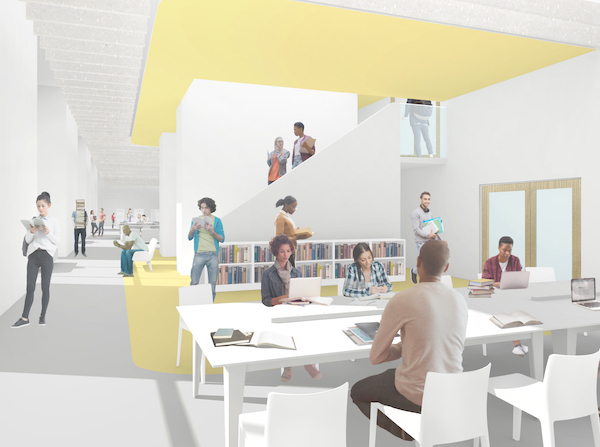
Conceptual rendering of the second floor reading room. Courtesy Kennedy & Violich Architecture.
While the architectural vision for the Hayden Library renovation took shape, another, equally important design process also has been playing out. The MIT Libraries Service Design Team, comprising staff from across the organization, has been tasked with rethinking what happens in Hayden once the library reopens.
“When we think about the future of Hayden, we’re thinking about much more than opening the doors to a beautiful, updated space,” says Karrie Peterson, head of Liaison, Instruction, and Reference Services and team lead for the Service Design Team. “We’re thinking carefully about the ways people will interact with library space, collections, technology, and people in the new Hayden. This renovation is an opportunity to work with our community to reshape those interactions in new and exciting ways.”
“I see service design as the bridge between the vision that Kennedy & Violich Architecture has created and the expertise of Libraries staff who understand our users’ needs and expectations,” says Cassandra Silvia, space project coordinator and member of the team.
Since January 2019, the Service Design Team has been planning not only how to ensure continued service through Hayden’s closure, but also how the Libraries can take advantage of the opportunities afforded by the renovated spaces. This work encompasess several phases, from providing input on the building design and furniture selection to imaging the evolution of Hayden programming well after the reopening.
“We have been looking at different aspects of library services and asking, what’s going to be different when the building opens?” says Peterson.
To tackle this challenge, the team broke down service design into the following categories, each guided by a principal idea:
- Community building: Create and enrich and connections between people; foster learning communities at MIT
- Student learning (including teaching support): Support students as consumers, creators, and influencers in the information ecosystem
- Research support: Support scholars doing research in the Libraries, especially computational research, while providing critical core services
- Consultations: Direct library users to the right expert, regardless of where they start or what they need
- Wellness: Understand and support people in our community holistically
- User experience: Offer efficient, reliable, and anticipatory services
Working with stakeholders across the Libraries, team members have considered how best to use new spaces to achieve the Libraries’ vision for each category. For example, the new event/teaching space brings opportunities to host new kinds of programs, such as a student panel on privacy or a hands-on transmedia storytelling workshop. Team members are exploring how a space designated for “mindfulness” on the quiet second floor can provide a technology-light oasis for students to take a break from studying. Others are strategizing how to create an atmosphere where library users ideally have to ask for help less often, but also feel welcome when they do.
It’s an ongoing process that considers how the Libraries support research, learning, and community at MIT well beyond the reopening, according to Peterson: “It’s finding the right balance of technology, furnishings, staffing, and other aspects of library space that works optimally for our community. Not just for opening day, but also for Year 1 and Year 5.”

